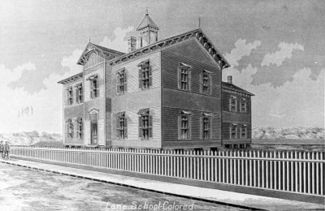Lane Elementary School: Difference between revisions
No edit summary |
|||
| (4 intermediate revisions by the same user not shown) | |||
| Line 14: | Line 14: | ||
}} | }} | ||
'''A. O. Lane Elementary School''', also called '''Lane Grammar School''', and, later, '''Cameron-Lane School''', was an elementary school in the [[Birmingham City Schools]] system located on the corner of [[18th Street South|18th Street]] and [[4th Avenue South]] in [[Birmingham]]'s [[Southside]]. It was constructed in [[1886]] as the first elementary school in [[Birmingham]] built to serve | '''A. O. Lane Elementary School''', also called '''Lane Grammar School''', and, later, '''Cameron-Lane School''', was an elementary school in the [[Birmingham City Schools]] system located on the corner of [[18th Street South|18th Street]] and [[4th Avenue South]] in [[Birmingham]]'s [[Southside]]. | ||
It was constructed at a cost of $6,000 in [[1886]] as the first elementary school in [[Birmingham]] built to serve Black students. The school was named in honor of Judge [[A. O. Lane|Alexander O. Lane]], who served on the [[Birmingham Board of Education]] from [[1884]] to [[1888]] and from [[1891]] to [[1904]] with several terms as president. | |||
In [[1902]] Principal [[Giddings Lewis]] was assisted by teachers [[Isabel Brooks]], [[Annie Payne]], [[Lizzie Jenkins]], [[Lillian Harris]], [[Lucy Hunter]] and [[Sadie Hunter]]. Enrollment that year was 650 students. | |||
By [[1923]] the Lane School was already outdated and overcrowded, with 945 pupils enrolled and an expected load of nearly 2,000 by [[1930]]. | By [[1923]] the Lane School was already outdated and overcrowded, with 945 pupils enrolled and an expected load of nearly 2,000 by [[1930]]. | ||
| Line 25: | Line 29: | ||
==Principals== | ==Principals== | ||
* [[ | * [[Bertram Hudson]], 1886 | ||
* [[F. S. Hazen]], 1887 | * [[F. S. Hazen]], 1887 | ||
* [[Giddings Lewis]] | * [[Giddings Lewis]], 1902–1924 | ||
* [[Leroy Butler]], 1948- | * [[Leroy Butler]], 1948-1949 | ||
* [[ | * [[Noah Wills]], 1950s–1967 | ||
==References== | ==References== | ||
* "The Lane and Cameron Schools" (May 26, 1902) {{BN}}, p. 1 | |||
* "Conditions at each of city's 70 schools analyzed in detail by City Planning Board." (February 15, 1952) {{BN}} | * "Conditions at each of city's 70 schools analyzed in detail by City Planning Board." (February 15, 1952) {{BN}} | ||
* Reeves, Garland (January 25, 1973) "[http://cdm16044.contentdm.oclc.org/digital/collection/p4017coll2/id/12290 Lane School picked for pilot project]" {{BN}} - via {{BPLDC}} | * Reeves, Garland (January 25, 1973) "[http://cdm16044.contentdm.oclc.org/digital/collection/p4017coll2/id/12290 Lane School picked for pilot project]" {{BN}} - via {{BPLDC}} | ||
Latest revision as of 19:11, 22 January 2024
| Lane Elementary School | |

| |
| Active | 1886–1960s |
|---|---|
| School type | Public |
| District | Birmingham City Schools |
| Grades | 1-5 |
| Colors | |
| Mascot | |
| Location | 410 18th Street South, (map) Birmingham |
A. O. Lane Elementary School, also called Lane Grammar School, and, later, Cameron-Lane School, was an elementary school in the Birmingham City Schools system located on the corner of 18th Street and 4th Avenue South in Birmingham's Southside.
It was constructed at a cost of $6,000 in 1886 as the first elementary school in Birmingham built to serve Black students. The school was named in honor of Judge Alexander O. Lane, who served on the Birmingham Board of Education from 1884 to 1888 and from 1891 to 1904 with several terms as president.
In 1902 Principal Giddings Lewis was assisted by teachers Isabel Brooks, Annie Payne, Lizzie Jenkins, Lillian Harris, Lucy Hunter and Sadie Hunter. Enrollment that year was 650 students.
By 1923 the Lane School was already outdated and overcrowded, with 945 pupils enrolled and an expected load of nearly 2,000 by 1930.
By 1952 Lane's building had been replaced and the student body merged with Cameron Elementary School to operate as Cameron-Lane School. The old Cameron Annex remained in use for some years afterward. $70,000 from the following year's $10.5 million 1953 bond issue was earmarked for improvements at Cameron-Lane.
Lane Elementary School was noted for its music program. Condoleezza Rice, who attended Hill Elementary School, was able, through her mother's influence, to join Lane's band program as a glockenspiel player.
In 1973 the Lane School was selected as the initial site for the E.P.I.C. program to merge students with disabilities into regular classes.
Principals
- Bertram Hudson, 1886
- F. S. Hazen, 1887
- Giddings Lewis, 1902–1924
- Leroy Butler, 1948-1949
- Noah Wills, 1950s–1967
References
- "The Lane and Cameron Schools" (May 26, 1902) The Birmingham News, p. 1
- "Conditions at each of city's 70 schools analyzed in detail by City Planning Board." (February 15, 1952) The Birmingham News
- Reeves, Garland (January 25, 1973) "Lane School picked for pilot project" The Birmingham News - via Birmingham Public Library Digital Collections